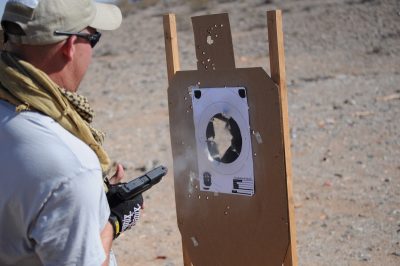
The fact is that almost all self-defense situations will be at ultra-short ranges, so training in that envelope makes good senses.
To many, time spent on the range consists of standing under a covered shooting line and plinking away at targets anywhere from 10 to 25 yards away. Because of range rules in many locations, we must set our gun on a bench while we reload. Running from a holster is seen as a liability to many ranges. Add to this the fact that many gun owners do not seek any professional training and a recipe for disaster is completely in play. The fact is that a majority of defensive shootings take place at what we will call “bad breath distance.” The aggressor will more than likely already be inside your personal space and the ensuing fight will be a close quarter battle. While a single article can never replace real-world training, I can at least offer a few suggestions to consider.
Where to Carry
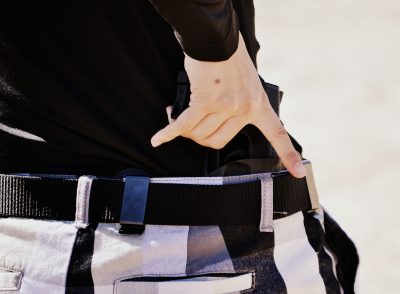
Inside-the-waistband carry rigs are popular with CCW users as they keep the gun tight and close to you while still being easy to access.
If you choose to carry a firearm as a defensive tool, you need to carefully decide where you will carry. Many factors will go into this, such as the gun you carry, your physique and your physical ability. The hard-fast rule, however, is that you need to be able to access the gun quickly and smoothly. There is a reason that hip or appendix style inside the waistband holsters are popular amongst serious shooters. It is because they are easy to access and draw from. They are in natural proximity to our hands and provide sufficient support to our guns. In short, you need to be able to get your gun into the fight right now. There will be no time for fumbling around while you dig it out.
My personal choice of concealed carry is at 2 o’clock on my right hip. I use an inside the waistband holster with two belt clips to ensure the holster stays in place with day to day motion. My choice of this location is based on several factors. First and foremost is that it is easy for me to quickly index my handgun should the need arise. My hand and gun are regularly in close proximity and I am confident in my ability to get my gun into the fight form this position. The second reason is that it is a comfortable location. I carry every day and this has proven to be a solid position for me. If you carry daily, you will quickly find out if your carry location is something that will be long term. Moving in and out of cars, sitting in various chairs as well as general movement will expose rubbing or jabbing from your rig. The last reason I choose this location is range of motion. While I have had students with almost superhuman flexibility, most people have a regular or even diminished range of motion in their shoulders and arms. Choose a position that you can easily get to without straining yourself in the process.
Modify Your Presentation
If you do actually train on your draw, you should also work on what are called “short draws.” This is a situation where you will not have the time or room to execute your standard presentation. The assailant may be too close to fully extend your weapon and you might have to engage them right as the gun leaves the holster. This is why it is essential that you have a very clean draw stroke with solid muzzle awareness. A close quarter shot using a short draw takes place after you have acquired your grip and drawn the pistol straight up out of the holster. At this point in a good draw you would lower your elbow and in turn, bring the muzzle to bear on the target. The support side hand will either be engaged on your torso or possibly pushing the assailant back. With the gun now out of the holster and pointed in at the attacker you can fire. There are obviously many moving parts to this scenario and you need to absolutely know where your support side hand is in relation to your muzzle. A quick note on firing from this position. You should focus on canting the weapon out towards the ejection port side just slightly to avoid self-induced malfunctions. You should also keep your forearm braced on your body to provide good recoil management. If the gun is too loose it will fire once, but can end up creating a stovepipe malfunction because of a lack of sufficient recoil control.
Get Back
Once you fire your initial shots on target, you need to work to break contact if at all possible. While John Wick may move from one CQB scenario to another as quickly as he can, we want to get some room to work. The greater the distance between us and the bad guy, the better off we are. Stay focused on the assailant as you move back and continue to engage them until they are out of the fight. Remember that just because they fall down, does not mean they are done. I would also caution you against any set pattern of fire such as the “double tap.” This can lead to a habit of stopping your shooting because of a drill as opposed to a solid result. While a “controlled pair” is a great drill, you should be ready for a “controlled magazine” should the scenario call for it.
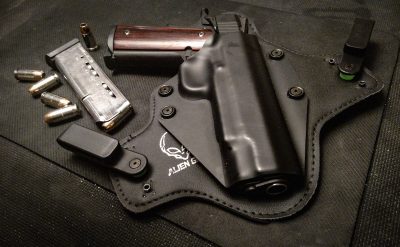
A good quality inside-the-waistband holster like this one from Alien Gear is well worth the investment.
Stay in the Fight
If you are ever attacked in close quarters there is a high probability that you will be injured in some way. It is essential to your survival and the survival of loved ones you are protecting that you do not let this distract you from the fight. The human body is exceptionally resilient and given time, you will heal from injury. You must armor your mind against pain and doubt as you fight. You should have an aggressive mindset and overwhelm your attacker. A fast, deliberate and violent response to an attack will break the assailant mentally as well as physically. There are no half-measures in close quarters fighting. By turning the tables on the attacker, they will very likely whither from the fight. They did not choose you as a target because they wanted to fight. They choose people they believe will be easy targets.
Train
This sounds like a broken record, but training is essential. There are many factors that you must experience in professional training that you will never get in an article. I am constantly amazed at the number of people that have never shot at targets at arm’s length. The sound and percussion that you get in these scenarios need to be experienced firsthand. My sincere hope is that you will never have to use these skills in a deadly encounter. My other hope though is that if you are forced into it, that you respond with a well-developed set of skills and win the day.
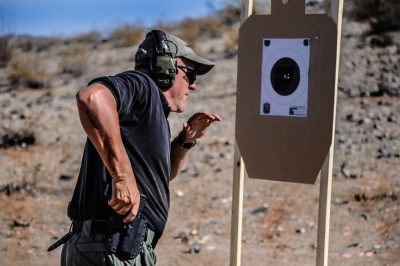
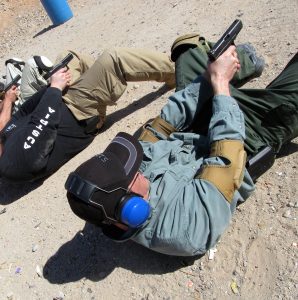
Great article with outstanding advice
People really do need to train for extremely close situations. My father was a State Trooper and when he went through the police academy firearms training they had the trainee’s stand 3′ from the target draw and fire one round and repeat. At the time most police officers were being shot at close range such as when they approached a drivers side window during a traffic stop.
This draw and fire was performed over and over until they could get reliably hit the target. Average number of rounds fired until the body shaped target was hit the first time was 50 shot, Your natural tendency is to draw and point the barrel straight foreword and fire. This causes you to miss the target to the right every time (or left if you are left handed). You have to train yourself to automatically turn the barrel inward before squeezing the trigger..
I never seen anyone in CQB sitting on their butt on the ground like Picture #4 and doing a half sit-up to Fire their Pistol or Rifle… People who do this crap are wannabes who most likely NEVER served in the Military much less been in COMBAT
I never cared for that training excercise either. Body parts are forward of the gun barrel as it is being fired.
Perhaps its to simulate being knocked down.
Air Force Combat Security, actually my team did train for this unexpected position, with a slight difference, our feet were crossed at the ankles. Arms were extended through the knees which were used as a steadying platform. Making physical contact with a guy trying to kill you can be a bitch. You don’t always wind up on your feet.
That is a position that is usually used in long range pistol shooting. BTW as a guy once told me when he was teaching me self defense shooting , “You don’t kill people for a living so your going to be really nervous.” Anything reasonable you can do at the spur of the moment to steady your aim will increase the likelihood of lead on target.
Thank you for your helpful article Mr. Mastison…I will take your admonition to “train.” To do so, please tell me how to find high quality training in my area? I have long wanted to learn more about self-defense, but I have not known how to access it. I would appreciate your advise.
Appreciatively,
Dr. George R. Chance.
Where to Carry? If CC is a requirement then that must be the first priority. You must lawfully Carry so you can continue to Carry Lawfully. Second is Accessibility, BY BOTH HANDS! Your support hand draw may not be pretty or fast but it must be effective with positive control. Our reflexes may send our strong hand into the physical fray first: that hand could get injured, held or need to keep holding something at bay. You must be able to draw with the support hand and engage the threat(s). Third is comfort, it is not legal problem or a life or death issue. This is where you get to make the results of 1 and 2 above, fit your body shape and provide a degree of daily comfort. You may need different holsters based on your varieties of wardrobe, environment and climate. Some people let the issue of “comfort” drive their firearm selection: Really? Write yourself a Note: I prefer to carry __ __oz less weight then carry a more capable firearm, then sign it, tape it to your chest: there’s Your Sign! Size, caliber, capacity and weight should only be a consideration for concealment never comfort. Lets be a little blunt here, some folks have a body shape that that eliminates a lot of IWB and OWB options and all draw with support hand. They may do better with a shoulder rig or off body discrete case (with lanyard). Please no fanny packs pinned under the spare tire or ankle holsters you can’t reach while on your back.
Okay, back to up close and personal.
Access by “Both Hands”? Can you elaborate on that? There are very few methods that would be practical for support hand/off hand access that I can think of. I regularly carry IWB at 4 O’ Clock. Impossible to get my left hand wrapped around my right side far enough. I do however have an ambi-external safety.
I would agree that both hand access would be nice, but not very practical especially if you have a retention holster to deal with. A long, long time ago I was taught to block with my weak side first, that allows you to throw the fight stopping punch of get your weapon out fast and into play regardless of the injury your weak side hand/arm may receive. This is something that I try to teach all the time whether or not it is a firearm based class. I even find myself falling into a weak side stance when something gets my ‘ruh rho’ attention. It is something anyone should/could practice along with being able to switch hands if you lose function in your strong hand.